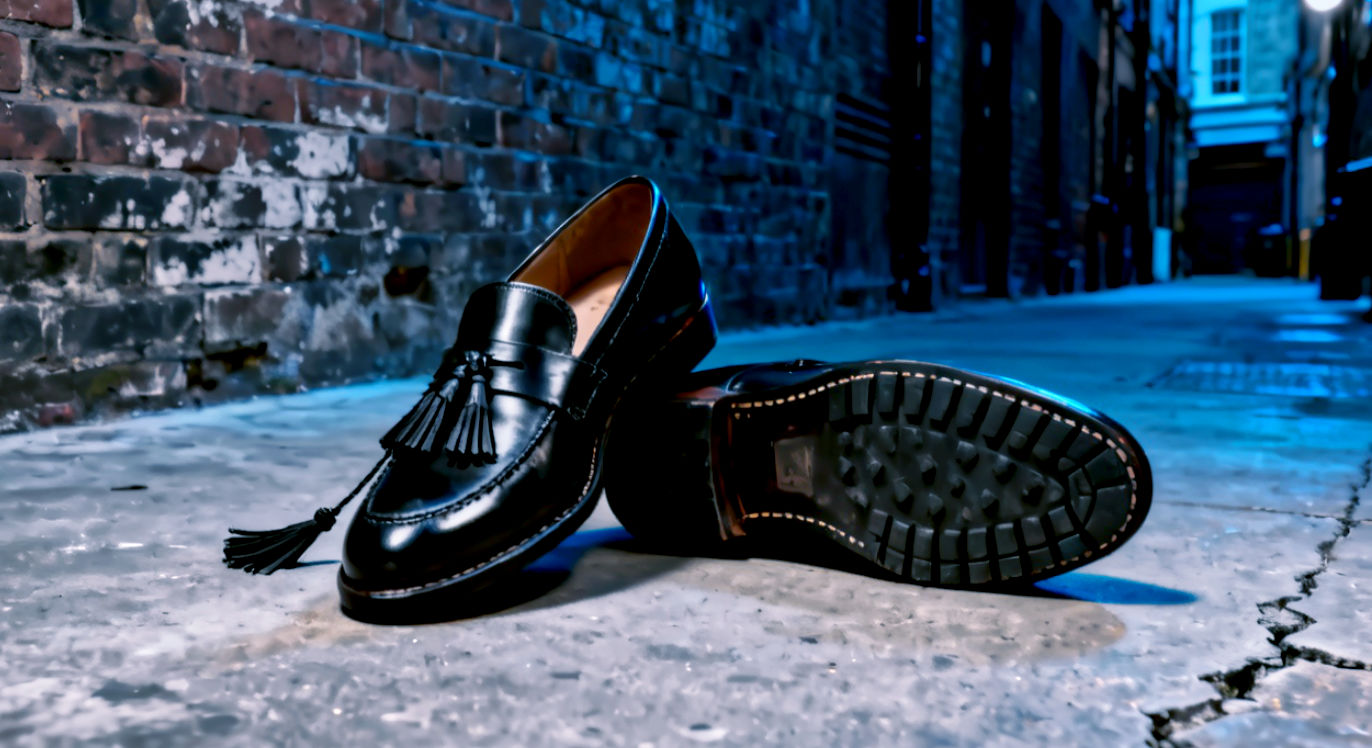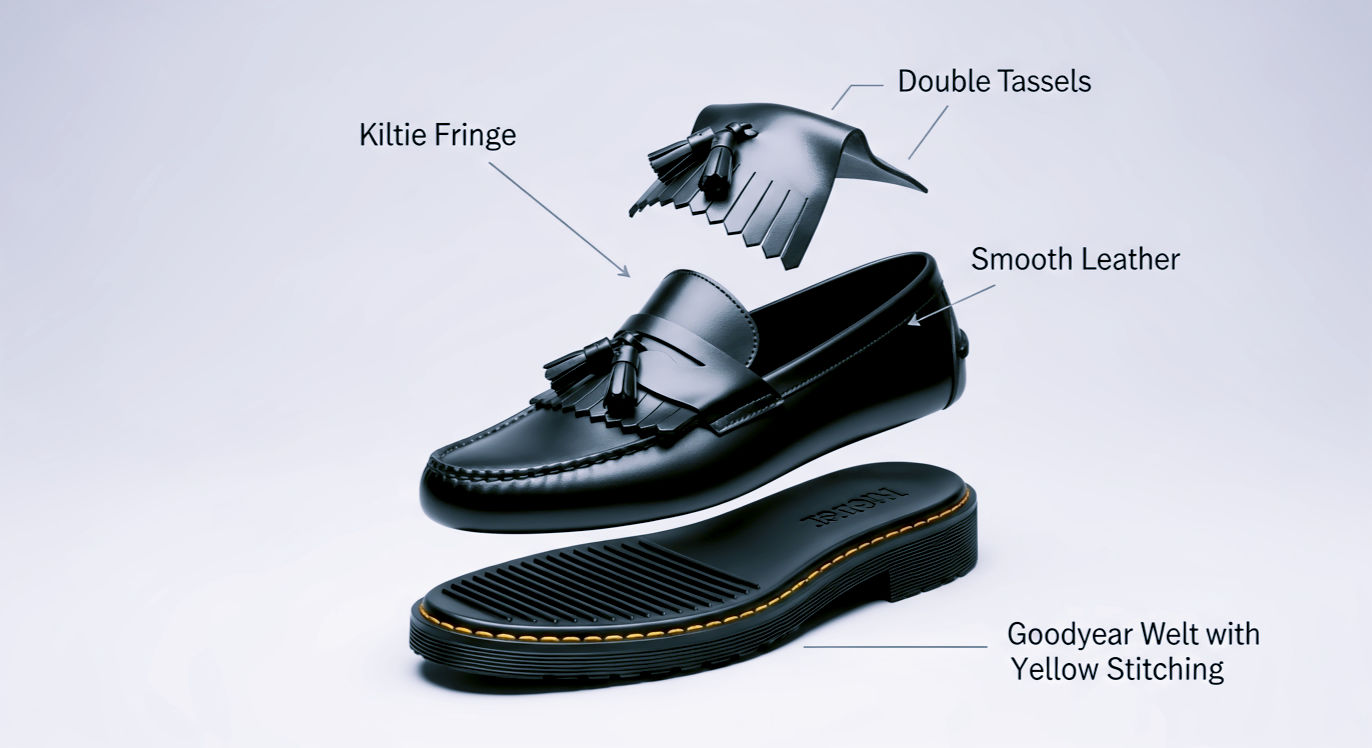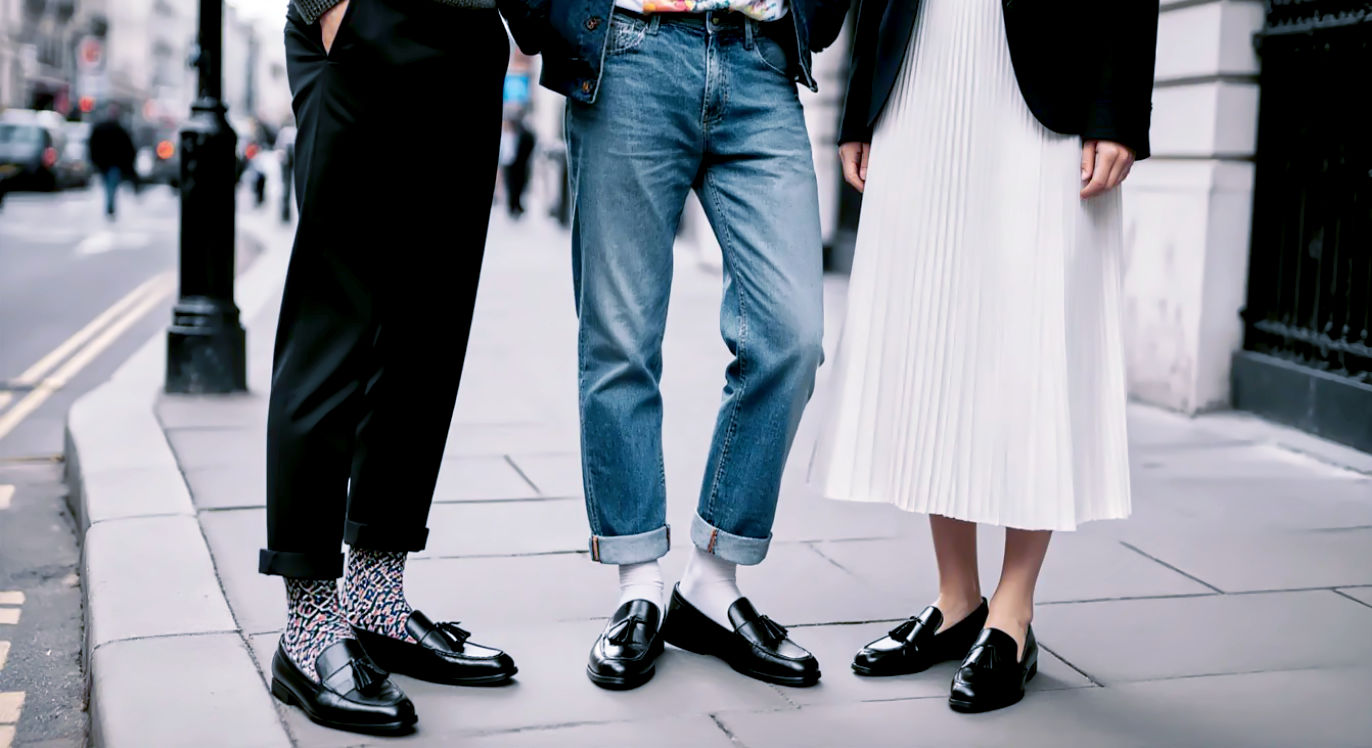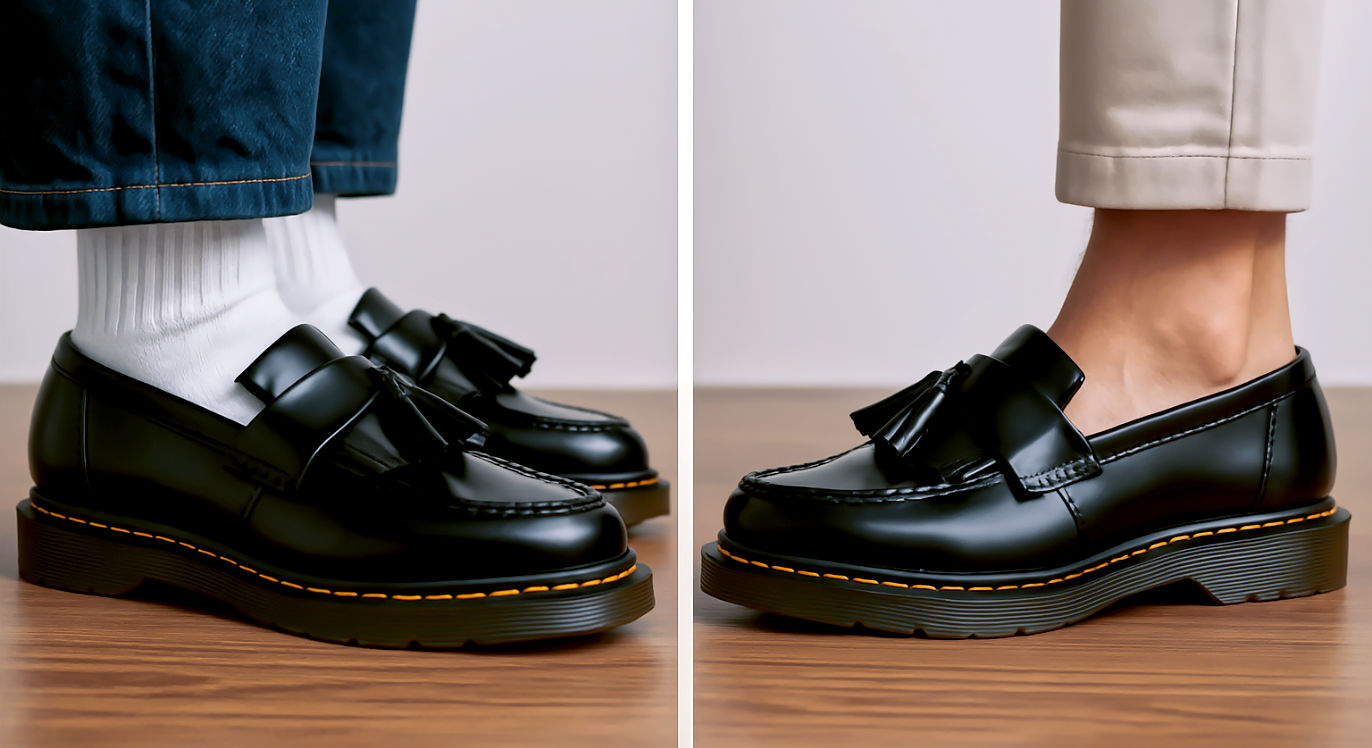Dr Martens Adrian Loafers: The Model That’s Converting Boot Loyalists
From Mod staple to modern classic, explore the complete history of the Dr. Martens Adrian Loafer. Our definitive guide covers styling, care, and its journey.

This post may contain affiliate links. If you make a purchase through these links, we may earn a commission at no additional cost to you.
For decades, the name Dr. Martens brought one image to mind: a chunky, eight-hole boot with a yellow-stitched, air-cushioned sole. It was the uniform of rebels, musicians, and anyone who refused to play by the rules. It was a symbol of stomping, defiant attitude. But over the years, something curious started happening. The same people who swore by their battered 1460s began slipping into something a little different, a little smarter, but no less rebellious: the Dr. Martens Adrian Loafer.
At first glance, it seems like an odd pairing. A loafer? The shoe of preppy students and city slickers? How could this smart, slip-on shoe possibly capture the spirit of a brand built on rebellion? Yet, the Adrian Tassel Loafer has quietly become one of Dr. Martens’ most beloved styles. It’s the shoe that bridges the gap between punk rock and smart tailoring, between the mosh pit and the office. It has managed to win over the most hardcore boot fans without losing an ounce of its parent brand’s tough-as-nails identity.
Dr. Martens Unisex-Adult Adrian Yellow Stitch Leather Loafers, Black, 12 Women/11 Men
-
A Subcultural Classic: As the first Dr. Martens shoe inspired by subcultures, the Adrian has been a core part of the collection for decades, rolling off the production line since the 1970s.
-
Iconic Design: Features a distinctive double tassel and kiltie fringe over the classic loafer silhouette.
-
Signature DM’s Construction: Built with a grooved two-tone outsole and reinforced with the instantly recognisable yellow welt stitching.
-
Durable Smooth Leather: Crafted from famously tough and hardwearing Smooth leather, which can be polished for a high shine or scuffed up for a worn-in look.
-
Goodyear-Welted: The upper and sole are heat-sealed and sewn together, not merely glued, ensuring greater comfort and durability for years of wear.
-
Heritage-Inspired Style: Fuses the smart, clean aesthetic of Mod culture with the legendary durability and attitude of Dr. Martens.
This isn’t just a story about a shoe. It’s a story about how a classic design can be remade, reinterpreted, and adopted by generation after generation. It’s about how that famous yellow stitching and bouncy sole can transform a traditional loafer into a statement of individuality. From its surprising origins in the sharp-dressed subcultures of the 1970s to its modern-day revival on city streets from London to Tokyo, the Adrian Loafer has carved out its own unique space. So, how did this polished slip-on manage to convert the boot brigade? Let’s find out.
The Unlikely Origins: From Ivy League to British Subculture
To understand the Adrian, you first have to understand the loafer itself. It wasn’t born in a British factory but on the campuses of America’s most prestigious universities in the 1950s. This was the era of ‘Ivy League’ style, where students wore a uniform of chinos, button-down shirts, and smart, comfortable slip-on shoes. The tassel loafer, in particular, was the height of sophisticated, casual cool. It was a shoe that said you were smart, a little bit playful, and definitely going places.
But like so many classic styles, it didn’t stay confined to its original tribe for long. By the 1960s, a new youth movement was bubbling up in Britain: the Mods. Mods were obsessed with sharp, clean, and stylish clothing. They looked to Italy and America for inspiration, blending tailored suits with an immaculate, almost obsessive attention to detail. And what shoe did they pair with their slim-fit trousers and fishtail parkas? The loafer.
The Mods took the preppy American loafer and made it their own. It was the perfect shoe for riding a scooter, for dancing all night to soul music, and for looking impeccably sharp while doing it. It was a subtle rebellion—a rejection of the scruffy, long-haired rocker look in favour of something clean, continental, and effortlessly cool.
Dr. Martens Enters the Fray
By the late 1970s, Dr. Martens was already a giant in British subculture. Their 1460 boot, originally designed as a humble work boot, had been adopted by skinheads, punks, and two-tone fans. The brand was synonymous with toughness, durability, and a working-class, anti-establishment attitude. So, when they decided to create a loafer, it was a bold move. How could they make a shoe associated with American preps and sharp-dressed Mods feel like a proper Dr. Martens product?
The answer was the Adrian Tassel Loafer, first produced in 1980 at the original Dr. Martens Cobbs Lane factory in Wollaston, Northamptonshire. The genius of the Adrian was that it didn’t try to hide its Dr. Martens DNA. It took the classic loafer silhouette—with its distinctive kiltie fringe and double tassels—and fused it directly onto the brand’s iconic air-cushioned sole.
The result was a brilliant contradiction. From the ankle up, it was a smart, traditional loafer. From the ankle down, it was pure, unapologetic Dr. Martens. The familiar yellow welt stitching, the chunky grooved sole, and the Goodyear welting construction were all there. This wasn’t just a loafer; it was a Dr. Martens loafer. It was tough, durable, and built to last, just like the boots. It could be polished to a mirror shine for a smart look, but it still had the heft and presence to feel like a proper piece of rebellious footwear.
The Anatomy of an Icon: What Makes the Adrian Special?
At its core, the Adrian Loafer is a simple shoe, but its design details are what make it a classic. It’s a perfect blend of traditional shoemaking and industrial grit. Let’s break down the elements that define this iconic slip-on.

The Kiltie and Double Tassels
The most eye-catching feature of the Adrian is its decorative front. This consists of two key parts:
- The Kiltie: This is the fringed leather panel that sits over the top of the shoe, just under the tassels. The name ‘kiltie’ is thought to come from its resemblance to the front of a Scottish kilt. It’s a traditional detail found on classic golf shoes and loafers, adding a touch of old-world, aristocratic flair.
- The Double Tassels: Sitting proudly on top of the kiltie are two leather tassels. Tassels on loafers were originally just a decorative way of finishing the laces that ran around the collar of the shoe. Over time, they became the defining feature of this style of slip-on.
On the Adrian, these traditional elements create a fantastic contrast with the rugged sole below. It’s a visual shorthand for the shoe’s personality: part refined, part rebellious.
The Famous Air-Cushioned Sole
Of course, it wouldn’t be a Dr. Martens shoe without the sole. Developed by Dr. Klaus Märtens and Dr. Herbert Funck in post-war Germany, the AirWair sole was a marvel of engineering. By trapping air in sealed compartments, it provided a level of comfort that was revolutionary for its time.
On the Adrian, this sole does more than just provide comfort. It gives the shoe its signature chunky silhouette and its unmistakable attitude. It’s what separates it from every other loafer on the market. While a traditional leather-soled loafer can feel delicate, the Adrian feels grounded, solid, and ready for anything. It’s a loafer you can stomp in.
The Goodyear Welt and Yellow Stitching
The final piece of the puzzle is the construction. Dr. Martens shoes are built using a Goodyear welt, a method of shoemaking that dates back over 150 years. In this process, a strip of leather (the ‘welt’) is stitched to the upper and the insole. The outsole is then stitched to the welt. This creates an incredibly strong and durable bond.
The process is heat-sealed at 700°C and reinforced with Dr. Martens’ signature yellow welt stitch. This bright yellow thread is probably the most recognisable brand marker in the world of footwear. On the Adrian, it serves as a proud declaration of its heritage. It’s a guarantee of quality and a badge of honour for those in the know.
A Shoe for Every Subculture: The Adrian’s Journey
While the Dr. Martens boot was famously adopted by a succession of loud, angry, and rebellious youth tribes, the Adrian’s path was a little quieter and more nuanced. It wasn’t the shoe for the front lines of the punk scene, but it found its home with those who blended smartness with attitude.
The Two-Tone and Ska Revival
In the late 1970s and early 1980s, the two-tone and ska revival scene exploded across Britain. Bands like The Specials, The Selecter, and Madness blended Jamaican ska rhythms with punk energy. Their look was just as important as their sound: sharp suits, pork pie hats, and smart shoes. This was a direct evolution of the original Mod style, and the loafer was a central part of the uniform.
For two-tone fans, the Adrian was the perfect choice. It was smart enough to wear with a suit, but its chunky Dr. Martens sole gave it the necessary edge. It connected the sharp, clean look of the Mods with the tougher, more streetwise attitude of the punk and skinhead scenes. It was a shoe that could take you from a gig to a job interview without missing a beat.
The Rise of ‘Casual’ Culture
In the 1980s, a new style emerged from the football terraces of Britain: the ‘Casuals’. This subculture was all about designer sportswear and looking sharp. While they were known for their expensive trainers from brands like Adidas and Diadora, they also had a smarter side. For a night out, a pair of smart trousers and a quality loafer were essential. The Adrian, with its blend of British heritage and tough-guy credibility, fitted right in.
The 90s and Beyond: Indie and Britpop
The Adrian continued to be a quiet favourite throughout the 90s, particularly within the indie and Britpop scenes. It was a slightly more grown-up alternative to the ubiquitous 1460 boot. You could imagine Damon Albarn or Jarvis Cocker wearing a pair with a vintage tracksuit top and a pair of straight-leg jeans. It was a shoe that said you were serious about your music but didn’t take yourself too seriously.
In recent years, the Adrian has seen a huge resurgence in popularity, especially in places like Japan and South Korea, where style tribes have adopted it as a key part of the modern, gender-fluid uniform. It’s also been embraced by a new generation in the UK who are discovering the brand for the first time, as well as by original fans who now want something a little more refined than their old eight-hole boots.
How to Wear Them: Styling the Adrian Loafer
One of the Adrian’s greatest strengths is its incredible versatility. It can be dressed up or down with ease, making it one of the hardest-working shoes you can own. Here’s how to style it for any occasion.

The Classic Look: Smart and Sharp
This is the Adrian in its natural habitat. The key here is clean lines and quality basics.
- Trousers: Opt for a slim or straight-leg trouser with a slight crop. You want the trouser hem to sit just on or slightly above the top of the loafer, showing a bit of ankle or a flash of a cool sock. Think tailored wool trousers, smart chinos, or even a pair of quality sta-prest trousers for a retro vibe.
- Socks: This is a chance to have some fun. A crisp white sports sock gives a modern, slightly preppy look. A patterned sock can add a pop of colour and personality. For a super-sharp, traditional look, you could even go for a fine-gauge sock in a block colour like burgundy or dark green.
- On Top: Keep it simple. A clean white t-shirt, a knitted polo shirt, or a classic Oxford button-down shirt all work perfectly. For outerwear, a Harrington jacket, a smart mac, or a tailored overcoat will complete the look.
This is a timeless style that works for the office, a dinner out, or a weekend in the city. It’s smart, but the chunky sole keeps it from feeling stuffy.
The Casual Approach: Relaxed and Rebellious
This is where you can lean into the Adrian’s Dr. Martens heritage. It’s about mixing the smartness of the loafer with more relaxed, workwear-inspired pieces.
- Denim: The Adrian looks fantastic with a good pair of jeans. A dark selvedge denim with a turn-up is a can’t-fail option. A lighter, washed-out denim can also work for a more laid-back, 90s-inspired look.
- Trousers: Think beyond jeans. A pair of fatigue pants, work trousers from a brand like Carhartt or Dickies, or even some wide-leg corduroys can create a really interesting contrast with the smartness of the loafer.
- On Top: A simple sweatshirt, a band t-shirt, or a flannel shirt all work well. A denim jacket or a workwear chore coat is the perfect finishing touch.
This look is all about playing with expectations. The smart loafer elevates the casual clothes, while the casual clothes make the loafer feel more grounded and less formal.
A Modern Twist: Pushing the Boundaries
The Adrian is also being adopted by a new generation who are styling it in fresh and exciting ways.
- With Shorts: In warmer weather, a pair of Adrians with tailored shorts and white socks is a strong look. It’s a bit preppy, a bit Japanese streetwear, and very cool.
- Gender-Fluid Styling: The Adrian is a truly unisex shoe, and it looks brilliant when incorporated into a more androgynous or gender-fluid wardrobe. Think wide-leg trousers, oversized shirts, and pleated skirts. The loafer’s classic design means it works seamlessly across different styles.
- Full Suit: For the truly brave, wearing a pair of Adrians with a full suit is a massive power move. It subverts the formality of the suit and adds a dose of punk attitude. It says you know the rules, but you’re choosing to break them.
The Adrian Family: Different Leathers and Variations
While the classic black smooth leather Adrian is the most famous, Dr. Martens has released it in a huge range of materials and colours over the years. Understanding the different options can help you find the perfect pair for your style.
- Smooth Leather: This is the original and most iconic version. The leather is stiff to begin with and requires a breaking-in period, but it will mould to your foot over time and develop a beautiful, unique patina. It can be polished to a high shine.
- Arcadia Leather: This is a high-shine leather with a two-tone effect. The top coat is designed to rub off over time, revealing a contrasting colour underneath. This gives the shoes a vintage, pre-worn look straight out of the box.
- Quilon Leather: This is a vintage-inspired leather that is crafted to replicate the original Dr. Martens leathers. It’s thick, durable, and has a matte finish.
- Suede: For a softer, more casual look, a suede Adrian is a great option. It’s comfortable from the first wear but does require a bit more care to keep it looking good.
- Vegan Leather: For those who avoid animal products, Dr. Martens offers a vegan version of the Adrian made from a high-quality synthetic material. It has all the same style cues, right down to the yellow stitching.
Beyond materials, Dr. Martens often releases special editions and collaborations, featuring different colours, hardware, and even platform ‘Bex’ or ‘Quad’ soles for extra height and attitude.
The Big Question: To Sock or Not to Sock?
It’s one of the biggest debates in the world of loafers: should you wear them with socks? The answer is: it’s entirely up to you. Both options create a completely different vibe.

- No Socks: Wearing loafers without socks (or with invisible ‘no-show’ socks) gives a relaxed, continental, summertime feel. It’s a classic Ivy League look that works well with cropped trousers or shorts. It keeps the focus firmly on the shoe and your ankle. However, be warned: wearing leather shoes without socks can get a bit sweaty, and it might wear out the inside of your shoes faster.
- With Socks: This is arguably the more versatile and more British way to wear them. As mentioned before, a crisp white sock is a modern classic. It provides a sharp, clean contrast that highlights the shoe. It’s a look that has roots in everything from 1950s Americana to 80s Michael Jackson. A patterned or coloured sock is a great way to inject some personality into a smarter outfit.
Ultimately, there’s no right or wrong answer. Experiment and see what feels right for you and your outfit.
Looking After Your Adrians: A Lifelong Investment
A pair of Dr. Martens is not a disposable fashion item; it’s an investment. With a bit of care, your Adrians can last for decades. Here are the essentials of Dr. Martens care.
1. Breaking Them In
The breaking-in period is a rite of passage for any Dr. Martens owner. The thick, durable leather can be stiff at first, particularly around the heel and across the top of the foot. Don’t despair! Here are some tips:
- Wear thick socks: This will protect your feet from blisters and help stretch the leather.
- Start slow: Wear them around the house for a few hours at a time before you attempt a full day out.
- Use Dr. Martens Wonder Balsam: This blend of coconut oil, lanolin, and beeswax helps to soften and condition the leather, making it more pliable. Apply it inside and out.
- Bend them: When you’re not wearing them, spend some time flexing and bending the shoes with your hands to soften up the stiffest points.
It might take a couple of weeks, but once they’re broken in, they will be some of the most comfortable shoes you own.
2. Cleaning and Polishing
Keeping your Adrians clean will prolong their life and keep them looking sharp.
- Remove dirt: Use a damp cloth to wipe off any mud or dirt. For stubborn marks, use a leather cleaner.
- Condition: About once a month, apply a thin layer of Wonder Balsam with a cloth. This will nourish the leather and prevent it from drying out and cracking.
- Polish: To bring back that shine, use a good quality shoe polish that matches the colour of your leather. Apply it with a brush or cloth, let it dry, and then buff it to a shine with a clean brush or cloth.
The Enduring Appeal: Why We Still Love the Adrian
So, why has the Adrian Loafer not just survived but thrived for over four decades? And how has it managed to convert so many die-hard boot fans?
Dr. Martens Unisex-Adult Adrian Yellow Stitch Leather Loafers, Black, 12 Women/11 Men
-
A Subcultural Classic: As the first Dr. Martens shoe inspired by subcultures, the Adrian has been a core part of the collection for decades, rolling off the production line since the 1970s.
-
Iconic Design: Features a distinctive double tassel and kiltie fringe over the classic loafer silhouette.
-
Signature DM’s Construction: Built with a grooved two-tone outsole and reinforced with the instantly recognisable yellow welt stitching.
-
Durable Smooth Leather: Crafted from famously tough and hardwearing Smooth leather, which can be polished for a high shine or scuffed up for a worn-in look.
-
Goodyear-Welted: The upper and sole are heat-sealed and sewn together, not merely glued, ensuring greater comfort and durability for years of wear.
-
Heritage-Inspired Style: Fuses the smart, clean aesthetic of Mod culture with the legendary durability and attitude of Dr. Martens.
The answer lies in its perfect balance. It’s a shoe of contradictions, and that’s what makes it so compelling.
- It’s Smart and Rebellious: It can be worn with a suit or with ripped jeans. It’s respectable enough for the office but tough enough for a gig. It walks the line between conformity and rebellion better than almost any other shoe.
- It’s a Symbol of Quality: In a world of fast fashion, the Adrian is a testament to quality craftsmanship. The Goodyear welt, the durable leather, and the iconic sole are all markers of a product that is built to last.
- It’s Ageless and Timeless: The Adrian has been adopted by countless subcultures and generations without ever looking dated. Its classic design means it will likely still be stylish in another 40 years. For boot loyalists who have grown up but not grown old, it offers a way to retain the Dr. Martens attitude in a slightly more refined package.
- It’s a Blank Canvas: Like all Dr. Martens products, the Adrian is a blank canvas for the wearer’s personality. How you style it, how you break it in, and the scuffs and creases it picks up over time all tell your personal story.
The Dr. Martens Adrian Loafer is more than just a shoe. It’s a piece of British design history. It’s a subcultural icon. And it’s proof that you don’t always need laces and eight eyelets to make a powerful statement. It’s the loafer for people who thought they’d only ever wear boots, and its quiet, confident rebellion is more relevant today than ever.
Further Reading
- Dr. Martens Official Website: Explore the history of the brand and the full range of Adrian Loafers.
- ‘A History of Modern Britain’ by Andrew Marr: For a deep dive into the post-war social history that shaped the subcultures that adopted Dr. Martens.
- ‘The Tanning of America’ by Steve Stoute: An excellent read on how brands cross over from subcultures into the mainstream.

